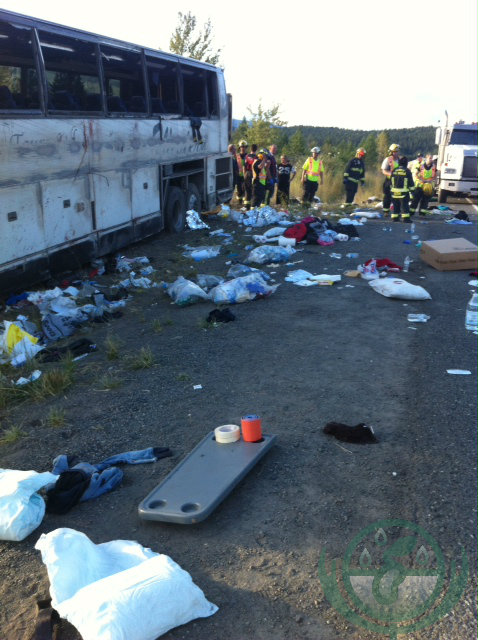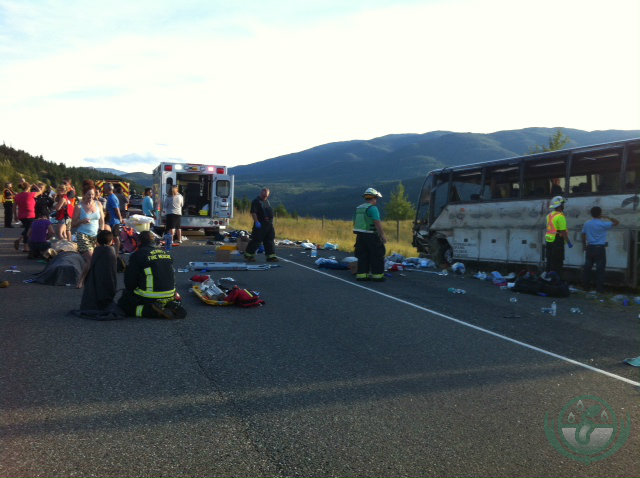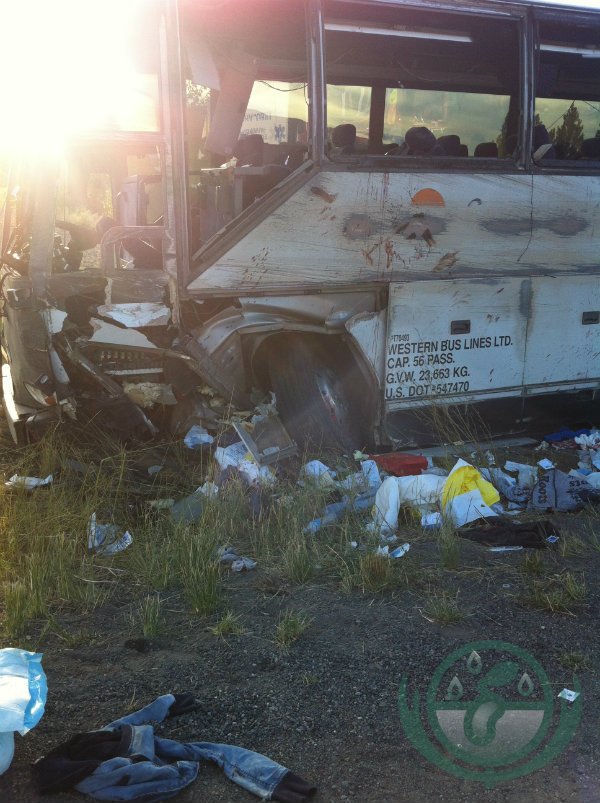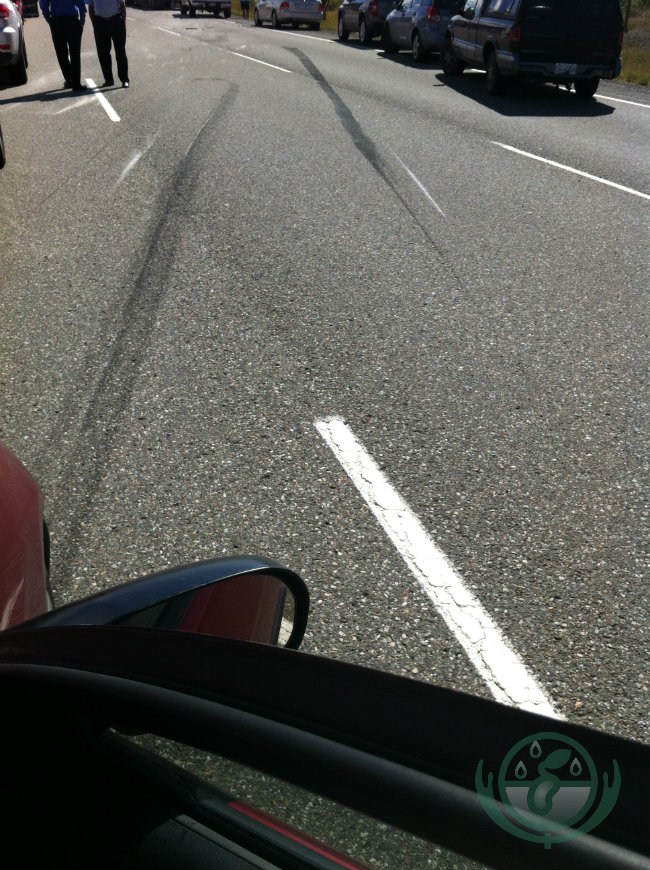**Trigger warning…some graphic accident info described. Stop reading if you could be triggered, please.
After 4 days of travel, we were on the Coquihalla, almost to our destination on the West Coast…and then we came upon the scene. The tour bus had done a complete roll, landing on the side of the highway…missing all the windows on the side I could see.
My thoughts are as jumbled as the scene we came upon. I find myself remembering snippets of the four hours we spent at the site…in snapshots and slices; in a disjointed jumble of jarring images not unlike the scene itself.
I remember the blood.
So. much. blood.
Everyone in the accident had blood on them. Everyone.
Running down arms. Little rivulets drying half way down a cheek. Big splotches on shirts. Everyone was bleeding.
I remember the initial chaos.
So many injured. So. many. injured.
My Junior Tribe Member (JTM) and I came upon the accident several minutes after it happened. We arrived about the same time as the first police car and ambulance. A few uniforms and so many more injured…though in the chaos, who knew how many? We now know over 50. People in the bus, and outside of it. So many seriously injured on the bus…and how to get them help and get them off…gosh, it was a mess.
“All those that can walk…go over to that truck.”
“No, all those that can walk…go over this way.”
“Put the stretchers waiting for an ambulance over here.”
“Hey, who put these stretchers here? The ambulances can’t get through!”
“Has anybody thought to look under the bus to see if anybody is under there? NO??? ok…go look!” (That was a tense moment, with much relief when no one was found.)

I remember the order arising from the chaos.
Two emergency room physicians and an off duty firefighter/on duty trucker and a first aid teacher were at the scene within minutes. (Amazing that, isn’t it?)
By the time I arrived the injured had plastic tags…red for needing critical attention, yellow for seriously injured but not critical, and green for minor injuries.
The red tagged folks were focused on first. My JTM was involved as they carefully compressed bleeding wounds, put folks on backboards, and prepared them to be flown away. IV’s were started, vitals were taken, charts were started.
A Cantonese speaking by-stander began asking questions and interpreting answers…and emergency personnel began to call her this way and that to establish order.
Cases of bottled water showed up, as did pillows, and blankets. Rolled up Tshirts compressed to broad gashed tied with strips of random cloth, gradually were replaced with more sterile bandages and gauze.
The folks with yellow strips had bystanders with them…shielding them from the blinding sun on the gravel side of the Number 1 highway…I sat with two different families over the four hours…keeping her conscious, letting a little one play with my phone, checking vitals, soothing and helping them to know they weren’t forgotten, even as it was taking time for them to get medical attention. Eventually, the physicians attended to them. A “green” fellow quickly changed to “yellow” as his symptoms worsened and was immediately attended to…the situation became well in hand.
Boxes of gloves, boxes of IV bags, tin foil blankets to stave off shock showed up in good supply. Styrofoam neck supports for all those who didn’t have a collar…and eventually, everyone had the support…and then they became useful mini-stools for those of us who had been sitting on the dusty highway for hours.

I remember the sounds
Helicopters are loud, up close–I had no idea how loud. I learned to mimic the ambulance folk…as one was taking off, we’d stop our tasks, and turn our backs to the incredible dust that was kicked up…and shield our victims–especially the open wounds–from the worst of it.
I remember the quiet. Sometimes, there were periods of no sirens and no helicopters. The highway was closed in both directions–no traffic sounds. So many of the victims knew no English, or very little…and many, when they spoke, did so very quietly, and had to be asked to repeat themselves louder.

I remember the tears
I sat first with two “yellows”– a university student, J. (bashed arms and bad scrapes) and his mother who had significant injuries to her middle section. The mother, S., cried twice.
Once S. cried one of the “reds” near her was being put on the backboard. Her screams were loud and tortured. S. cried as she heard her fellow traveller in agony.
The second time was when her son, J, was having his arms given proper first aid. He screamed as they poured liquid on the long open gash on his arm and they straightened it–was his elbow broken? She wept as her son was in anguish.
My second family was a “yellow” mom, Y., with a “green” husband and toddler daughter. Y’s mom was also on the bus…a “red” victim, bleeding badly from critical spots and had been heli-ported. Y. was one of the last victims to leave the scene…it was going on 4 hours and she had no idea how her mother was doing. She wept talking about her concern for her mother.
The only crying I saw–it was accident victims weeping for the others.
I remember the humanness of it all
I sat, for what I found out later, was a total of 4 hours, with two different families. That’s a long time…and while some of it was providing care, and supporting the work of the emergency workers…there was a lot of time to just “be”.
To be with victims, to support them, to get to know them…to while away the hours in a way that was “least worst”.
I offered my phone to J. to call his dad in Beijing. His cell phone was missing in the chaos. We giggled as one hand was too mangled to tap numbers, and the other arm’s elbow couldn’t bend to dial. I tried to understand his broken and frightened English to dial for him…until his seriously injured mother told him to not call–she was worried about bothering him in his busy schedule.
I was encouraging J. to drink in the blistering heat…and held the bottle to his lips. After a while, he shyly explained his reluctance to drink too much. His arms and hands were both injured, and he didn’t know what he’d do if he had to pee. We laughed at that too.
Wondering about finding passports…or leaving them inside the bus while they went away…the ordinary stuff of life even as we wondered about lives lost, and the severity of injuries of those waiting for hospital yet.
Y spoke great English…and we spoke about raising children, and university education, and matters of faith. She spoke about taking her child to preschool, and I spoke about taking mine to university. We talked about Lake Louise and canoeing and the beauty of the mountains. We visited…sounds odd, but when you’ve been on a hard backboard for 3 hours and that alone is darn uncomfortable, and you’ve lost your glasses and can see very little…I think the chatter was a great distraction. She was a lovely lady. We prayed together.
She spoke about her fear of closing her eyes at night because of the images of blood she knew she’d see. I didn’t tell her then–it wouldn’t have been right–but I shared that fear. She and her husband told stories of the accident…and I found out for the first time that it was a busload of Mandarin speaking folks heading home from their tour.
We became friends…and exchanged email addresses and phone numbers. Folks sharing a horrific experience and being human within it all–and connecting deeply.
I remember the community that quickly developed
The accident victims outnumbered the paramedics. The doctors on site knew what they were doing. Important assistance was given before the uniforms got there–paramedics, RCMP and firefighters–and when they arrived, they seamlessly joined in the team…respecting us roadside volunteers, while we respected their ability to do their jobs.
When it was time to roll a victim onto a spinal board, someone would call out and 8-10 people would quickly gather to gingerly do the job…and then, on one paramedic’s count–on three–together lift the board onto a stretcher.
Strangers worked together cooperatively in ways that I marvelled at, even at the time. A firefighter started a file on S.–I was closer to her son, and asked the questions to gather history–while she scribed the responses. She called on passersby for a pen…and then later gave the pen to another who needed it.
Later, when J and S were stowed in the ambulance, both attendants left to go get one more victim to fill the ambulance…and asked me to look after the victims in the ambulance for the 10 minutes they were gone. They trusted me, a stranger…and then chuckled as J and I exchanged a meaningful good-by and a promise to text each other.
I remember the love and the gratitude.
The feeling of community was palpable…as the last of the victims were being loaded, I went to give one of the physicians a hug…she had been working tirelessly for 4 hours–and I wanted to see how she was doing. She quickly hugged me and bustled off to go give my son a hug: “I gotta go find that young man in the striped shirt…he was incredible”. She expressed her gratitude and encouragement to him for his role in helping her.
The RCMP officer in charge spent a few minutes with us…and also expressed her gratitude at the “helpful young man”–my son. The first aid teacher that helped told me to have some more kids just like him.
I remember the text I got from J yesterday…he and his mom are on the mend, and in his broken English, he said: “Thank you very much, Carolyn. I will never forget you. I love you.”
Not sure how his injured fingers, hands and arms worked to be able to send that text–I know it couldn’t have been easy…and yet he troubled himself to send it. That sort of gratitude–the thinking outside of himself, even at such a time of tragedy–moves me.
I remember being parked on the tire marks
As the last two victims awaited their turn to be transported, an RCMP officer called my name out at the scene–odd, I thought, that he had my name.
I left my car a couple of dozen yards back on the inside lane of the highway, window wide open and doors unlocked, purse inside–leaving for what I thought was a minute–not realizing it would be 4 hours before I would return. He had opened the glove compartment to see who owned the vehicle. I ran back, thinking of the vehicle for the first time…so many people had been around the scene–and my unlocked car with my purse sitting on the front seat.
It was all safely untouched.
There is a lot more going right in this world than going wrong with it, I think.
Unbeknownest to me, hours earlier, I had parked on the tire tracks of the bus, where the terrible scene had begun. Now, before opening the highway, they needed to measure the scene for the investigation…so I needed to move my car.
Isn’t that so often what life is like? We can park ourselves on the accident scenes of others without even knowing we are–and for hours be blissfully ignorant that we are firmly planted on catastrophe without awareness.
I had thought I was fine–I was calm–after all, I wasn’t in the accident, right?
Then, as I backed up, I drove over one of the cones designed to protect the scene.
It was bright orange…pretty difficult to miss…but I missed it.
Trauma…even being a bystander–affects us, even when we may not be aware of it–decreases sensitivity, increases response times…just making a person a little more clumsy in trauma’s wake.
The RCMP officer…he was kind and gentle and appreciative to me…even as he was going about his official investigation with his colleagues.
The story, as I remember it–well, it will include the blood and the blood-curdling screams–but it will also even more include the cooperation, the gratitude, the teamwork, and the friendships.










Write a Comment